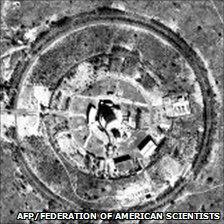Pakistan's growing nuclear programme
- Published

Pakistan has had nuclear facilities since the 1960s
Pakistan's first nuclear reactor was established with help from the United States in 1965 during the regime of military dictator Gen Ayub Khan.
Gen Khan's protege and then foreign minister, Zulfiqar Ali Bhutto, was the driving force behind the programme, which was based at Nilore near Islamabad.
It was set up under the Atoms for Peace programme initiated by President Dwight D Eisenhower.
At the time it was strictly peaceful and intended to help meet Pakistan's civilian energy needs under the supervision of the International Atomic Energy Agency.
A few years later Zulfiqar Ali Bhutto became prime minister. He launched a nuclear weapons programme in 1974 as India and Pakistan competed in a new South Asian arms race.
Codenamed Project 706, Pakistan's plan to enrich its own uranium was conceived and led by Munir Ahmed Khan, a brilliant US-trained nuclear and electronics engineer.
He was joined a year later by a name that is now synonymous with Pakistan's nuclear programme - Dr Abdul Qadeer Khan.
It was Dr Khan - later disgraced for transferring technology to Iran and Libya - who was instrumental in setting up Pakistan's first nuclear enrichment plant at Kahuta near Islamabad.
Project 706 thus became Kahuta Research Laboratories, where enriched uranium for Pakistan's first nuclear weapon was produced.
Pakistan is believed to have developed a nuclear device by 1984, when Dr Khan alluded to it in an interview with a Western journalist.
Since then Pakistan's nuclear power complex has undergone a rapid expansion.
Dr Abdul Qadeer Khan developed Pakistan's nuclear bomb
The organisation in charge is the Pakistan Atomic Energy Commission (PAEC), which is headed by a civilian nuclear physicist or engineer.
It operates eight fuel production and enrichment facilities, three mining concerns and one heavy water production facility.
The original bomb was a small uranium device with about the power of those the US dropped on the Japanese cities of Hiroshima or Nagasaki.
It was unwieldy and could only be launched from a bomber specially fitted for the purpose.
But Pakistan has made rapid advances since then - it is now said to have 70-90 weapons in its stockpile.
Many of these have been miniaturised to be mounted on ballistic missiles with ranges of more than 2,000km (1,245 miles), bringing many Indian cities within reach.
China is believed to have played a critical role in Pakistan's nuclear programme, and is said to have helped it manufacture many of its weapons.
Nuclear weapons development and advancement in Pakistan is primarily done by PAEC with Chinese collaboration, reports say.
Western officials believe that long-range missile technology was also acquired from North Korea in the 1990s - in exchange for Pakistani help with its nuclear programme.
Meanwhile, proliferation experts believe Pakistan continues to make rapid strides in the development of uranium enrichment facilities and its weapons development complex.
Work has been proceeding rapidly on the construction and expansion of plants in Chasma and Sihala.
Pakistani engineers, with help from the Chinese, are also said to be in the advance stages of developing MIRV technology for its missiles. This would allow the military to fit several warheads on the same ballistic missile and then launch them at separate targets.
Security
PAEC has hundreds - perhaps a few thousand at most - civilian employees working directly for it. An exact figure is not available. They include scientists and engineers, as well as technicians and other support staff.
Pakistan is thought to have acquired missile technology from North Korea
In all, tens of thousands of security and other personnel are thought to work in Pakistan's nuclear complex.
Because of security concerns all PAEC staff are said to be thoroughly screened by Pakistan's intelligence services.
These have been expanded to include checks on any sort of connection to extremist religious organisations.
Post-9/11, several Pakistanis scientists were arrested for alleged links to al-Qaeda.
While most of them were released after several months of interrogations, additional scrutiny is now given to all serving and prospective employees, intelligence officials say.
Pakistan denies this is under pressure from the US, but concerns from the country's largest investor carry a lot of weight here.
The weapons themselves are then transported and stored by the Strategic Plans division of the army.
In recent times, they have been kept at depots all over the country. Some are said to be near the main air bases, while others are outside the purview of any sort of inquiry.
Pakistan's army remains secretive about the locations of its weapons - although US officials have openly said they believe they are in safe hands.
In the last few years US technical experts are said to have provided training for the Pakistanis on safe nuclear storage procedures and facilities.
The Americans are also believed to have provided $100m (ВЈ64m) to be used to enhance the security of Pakistan's nuclear stockpile.